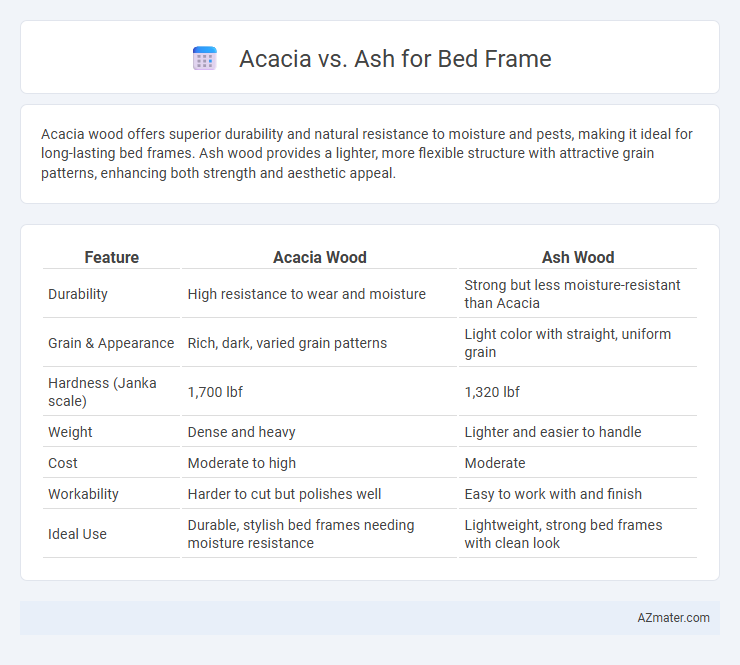Acacia wood offers superior durability and natural resistance to moisture and pests, making it ideal for long-lasting bed frames. Ash wood provides a lighter, more flexible structure with attractive grain patterns, enhancing both strength and aesthetic appeal.
Table of Comparison
| Feature | Acacia Wood | Ash Wood |
|---|---|---|
| Durability | High resistance to wear and moisture | Strong but less moisture-resistant than Acacia |
| Grain & Appearance | Rich, dark, varied grain patterns | Light color with straight, uniform grain |
| Hardness (Janka scale) | 1,700 lbf | 1,320 lbf |
| Weight | Dense and heavy | Lighter and easier to handle |
| Cost | Moderate to high | Moderate |
| Workability | Harder to cut but polishes well | Easy to work with and finish |
| Ideal Use | Durable, stylish bed frames needing moisture resistance | Lightweight, strong bed frames with clean look |
Introduction to Acacia and Ash Wood
Acacia wood, known for its durability and rich grain patterns, offers a dense, water-resistant material ideal for bed frames that require strength and aesthetic appeal. Ash wood, valued for its light color and exceptional toughness, provides a flexible yet sturdy option that resists wear and absorbs shocks effectively. Both woods are popular choices in furniture making, with Acacia leaning towards a more exotic look and Ash offering a classic, clean finish suitable for various interior styles.
Key Characteristics of Acacia Wood
Acacia wood features a dense, durable grain with natural resistance to moisture and decay, making it highly suitable for bed frames requiring long-lasting strength. Its rich, warm tones and smooth finish enhance the aesthetic appeal, providing a unique, elegant appearance compared to the lighter ash wood. The high tensile strength and termite resistance of acacia ensure structural integrity and longevity in bedroom furniture.
Key Characteristics of Ash Wood
Ash wood offers exceptional strength and durability, making it ideal for a sturdy bed frame. Its light color with prominent grain patterns enhances a natural, aesthetically pleasing design. Known for excellent shock resistance and flexibility, ash wood maintains structural integrity under daily stress.
Durability: Acacia vs Ash for Bed Frames
Acacia wood offers exceptional durability for bed frames due to its high density and natural resistance to moisture and pests, making it ideal for long-lasting furniture. Ash wood, while slightly lighter than Acacia, provides remarkable strength and flexibility, resisting wear and impact effectively. Comparing both, Acacia tends to outperform Ash in terms of hardness and longevity, ensuring a sturdier bed frame that endures daily use.
Appearance and Aesthetics Comparison
Acacia wood features a rich, warm tone with pronounced grain patterns that bring a natural, rustic elegance to bed frames, often displaying hues from golden brown to deep amber. Ash wood offers a lighter, more uniform color palette, typically creamy white to light tan, with subtle, straight grain patterns that create a sleek and modern aesthetic. Both woods provide distinctive visual appeal; Acacia's bold character suits traditional or eclectic interiors, while Ash complements minimalist and contemporary bedroom designs.
Maintenance and Care Requirements
Acacia bed frames require moderate maintenance due to their natural oils that provide some resistance to moisture and pests, but regular polishing or oiling enhances their durability and appearance. Ash bed frames benefit from a dense grain structure, making them easier to clean with simple dusting and occasional waxing to prevent drying and cracking over time. Both wood types should avoid excessive moisture exposure to maintain structural integrity and prolong the lifespan of the bed frame.
Environmental Sustainability of Acacia and Ash
Acacia wood is renowned for its fast growth and high density, making it a more sustainable choice for bed frames due to quicker replenishment and durability. Ash trees also provide eco-friendly benefits with their strong, lightweight timber often sourced from sustainably managed forests supporting biodiversity. Both Acacia and Ash offer renewable options, but Acacia's rapid growth cycle typically results in a smaller environmental footprint compared to slower-growing Ash species.
Cost Analysis: Acacia vs Ash Bed Frames
Acacia bed frames generally cost more due to the wood's durability, resistance to insects, and rich grain patterns that enhance aesthetic appeal. Ash bed frames tend to be more affordable, offering a lighter-weight option with good strength but less natural resistance to wear. When comparing cost efficiency, Acacia provides long-term value through longevity, while Ash is budget-friendly upfront with moderate durability.
Pros and Cons of Acacia for Bed Frames
Acacia wood offers exceptional durability and natural resistance to moisture and insects, making it ideal for long-lasting bed frames. Its rich, warm hues and unique grain patterns add aesthetic appeal but can vary widely, potentially leading to inconsistencies in appearance. While Acacia is often more affordable than Ash, it tends to be heavier and harder to work with during customization or assembly.
Pros and Cons of Ash for Bed Frames
Ash wood offers excellent strength and durability for bed frames, making it resistant to warping and ideal for long-term use. Its light color and attractive grain provide a modern, clean aesthetic that complements various bedroom styles. However, ash is more prone to dents and scratches compared to harder woods, requiring careful handling and regular maintenance to preserve its appearance.

Infographic: Acacia vs Ash for Bed Frame
 azmater.com
azmater.com